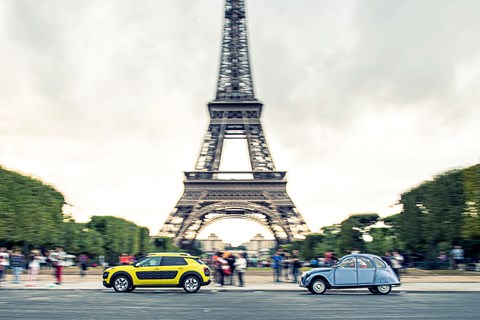► Citroen C4 Cactus meets 2CV
► CAR magazine twin test in Paris
► French rediscover simple style
The city of light has become the city of lightning. Summer thunderstorms sweep over the boulevards and belle époque buildings of Paris. We stop our Citroën C4 Cactus and our 2CV outside the ornate Grand Palais, near the Place de la Concorde – where Louis XVI and his queen were beheaded – and just over the river from Les Invalides, where Napoleon is entombed.
The French Revolution overthrew a king and ended with an emperor, after a lengthy period of anarchy in between. Plus ça change, plus c’est la même chose. (The more things change, the more they stay the same.)
It’s a similar story with Citroën. The world’s boldest car company was France’s very own auto revolutionary, and after a succession of sublimely engineered step-ahead cars from the 1930s to the early ’70s – cars that bristled with technology and intelligence – so Citroën was subsumed into the more cautious Peugeot corporation.
How Citroen lost its way
It had gone bankrupt (again). Consumers outside France failed to understand the benefits of its idiosyncratic cars. In addition, its innovations were largely spurned by a car industry either too stupid, or more likely too frightened, to follow. We motorists are still the poorer for their ignorance.
Under Peugeot, Citroën went through its own prolonged period of anarchy. There were occasional flashes of flair – think BX, think XM. Mostly, there were just rebodied Peugeots, Citroëns in name but not in character.
But, just as the French Revolution went partly full circle, so it seems has Citroën. They may never quite rediscover the wizardry of the DS or the 2CV. The new C4 Cactus, though, is a sure sign of better days ahead. It is a brilliantly ‘think different’ approach to one of the most flawed breeds of car, the SUV-inspired crossover.
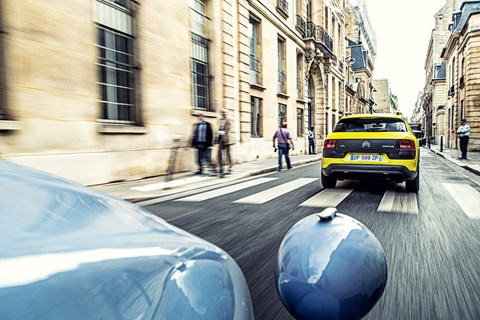
This is a booming market, exploding from Beijing to Birmingham, from Boston to Bangkok. The upmarket Germans plough in with their pricey ‘soft roaders’. The mainstream European, American and Japanese launch new cars mechanically based on everyday hatches but with greater styling attitude and elevated driving positions (and elevated prices as well). Even the 4×4 specialists jump on the bandwagon. These cars are typically taller, heavier, slower, thirstier, less responsive, less aerodynamic and less agile than the same-length hatches, estates and saloons whose popularity they usurp. They defy the green agenda our rulers urge us to embrace, and which common sense dictates we should follow.
Yet they are often no roomier and no more practical than same-size ‘conventional’ cars and, with a few notable exceptions, are no more capable when conditions turn tough. They are rarely more versatile. Their steroidal style has somehow convinced young mothers that the school run will be safer, while their extra armour plating makes the insecure feel braver. This class of car is ripe for revolution, and Citroën has fired the first shots across the barricades.
As with all the great Citroëns, the C4 Cactus is not easy to categorise. While it most conveniently fits into the small crossover class, its low price – from just £12,990 – means it also competes with the more basic Fiestas and Polos, never mind that it’s much roomier. The C4 Cactus sits a little higher than a conventional hatch, although its roofline is lower than the tallboy crossovers.
Its revolutionary and oh-so-sensible ‘Airbump’ side panels, to avoid shopping-centre scrapes, imbue it with a certain armour-plated styling toughness, even if the armour is made of rubber. It looks functional and funky, with its protective perimeter shell. It also has all the safety features that modern mothers could wish.
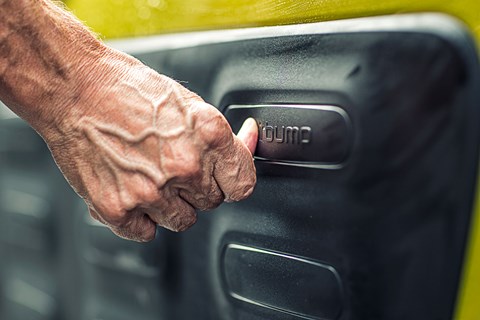
Yet, in its more basic guises, it weighs under a tonne. That’s typically 200-600kg less than rivals. It’s 200kg lighter than a basic Mini hatch and as roomy as a Focus.
That light weight means better fuel economy, better CO2, sharper agility, lower tyre wear and all the other panoply of benefits that accrue from being featherweight not fat.
A high use of aluminium – including the bonnet – helps. More important for weight paring, Citroën did not engineer the Cactus – unlike most crossovers – for pricier iterations with bigger engines, four-wheel drive, seven seats or a longer wheelbase. This policy invariably means the more economical versions are saddled with unnecessary flab and over-sized components. It’s like designing a pair of running shoes and shorts for Jonah Lomu and expecting Mo Farah to wear them too. The Cactus was designed, exclusively, for small, lightweight engines, and front-drive only. It subscribes magnificently to the Swedish concept of ‘lagom’ – just right.
The design story
The design team, working under Brit Mark Lloyd, ruthlessly tried to reduce waste and eliminate the unnecessary. (Eighty years ago, the 2CV designers did exactly the same.) They used pop-out rear windows not heavier winding windows, a one-piece rather than a split rear seat, and windscreen washer jets positioned in the tips of wipers not on the base of the windscreen: it’s more efficient and reduces the size of the washer bottle by half, saving weight. It also means no more dirty marks sprayed onto the bonnet or roof. The thermally insulated panoramic sunroof shades occupants from bright sunshine without the need for a heavy additional blind.
Yet, as we sit inside our Cactus, with tourists swarming past and looking inquisitively, it does not look or feel cheap, and is well-equipped: our test car uses the fine little triple-cylinder petrol turbo also found on the most appealing version of the Peugeot 308, and features a reversing camera, sat-nav, automatic air conditioning, parking sensors, a six-speaker hi-fi, Bluetooth, 17-inch alloys, and still weighs just over a tonne.
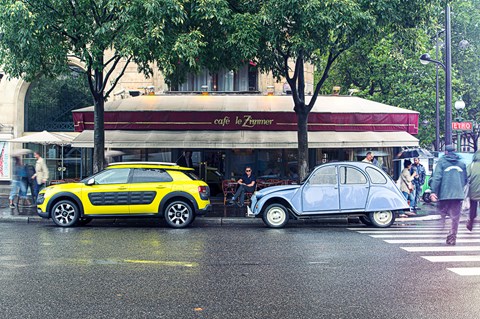
So our C4 Cactus and our 2CV stop outside the Grand Palais, surely the world’s most magnificent exhibition hall, sheltering from the August tempest. It was here, 59 years ago, that the world’s most modern car was launched. The Citroën DS was the biggest single step-ahead car of its time, and perhaps of all time, setting new standards for handling, ride and braking. It was peppered with advanced technology. High-pressure hydraulics controlled the self-levelling suspension, the brakes, the clutch and the gearchange. It operated the steering too, and was probably the first car with acceptable power steering.
The hydraulics were also used to help change wheels. It had disc front brakes when rivals had cruder drums, and load-sensitive anti-lock rear brakes. Michelin X radial tyres gave outstanding grip and handling, boosted by the front-wheel drive stability. It had a translucent roof of resin-bonded glassfibre, the precursor to today’s panoramic roof. It had a button not a pedal for brake actuation (more space efficient and safer – brake pedals can cause appalling foot injuries), an innovation still ignored by the car industry).
Later versions had swivelling headlamps to ‘see around corners’ – an innovation many car makers are only just discovering. What’s more, it was all wrapped in a body that was as sleek as a shark, in an age when cars typically looked more like Dumpy Fish, with aerodynamics to match.
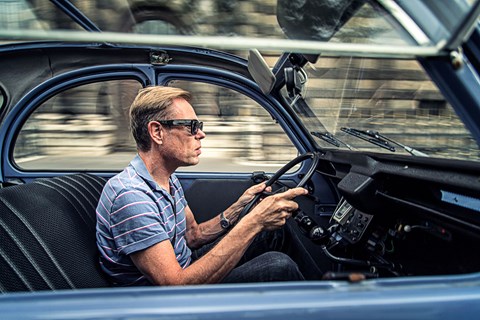
Today, parked alongside our C4 Cactus, we also have the second-greatest Citroën ever made. It, too, made its global debut inside this imposing Beaux Arts building. The 2CV, launched in 1948, was a very different machine from the DS, but barely less innovative.
It was a rural car, designed for the shallow-pocketed peasantry, the biggest chunk of France’s population. It was not a small car, unlike the Austin Seven and Fiat 500 that respectively put Britain and Italy on wheels. Rather, it was light and frugal, possibly the most intelligently conceived minimalist car ever launched. It was a car of utility, economy and logic, conceived before the war, and retrieved (from the prototypes’ hiding place in a loft) after it.
Cactus: inspired by 2CV?
Can the new C4 Cactus possibly compete with that catalogue of creativity? Of course it can’t! But it is a worthy and innovative car all the same, espousing many of the priorities and prejudices that inspired the older generation of Citroën engineers.
Measurement – the Cactus’s low weight, low cost, decent equipment, excellent fuel figures – is of course important. But, as with all great cars, emotion is just as important. Those belle époque Citroëns gave a warm glow of satisfaction to owners. I know this well, having owned two 2CVs (in the ’80s) and, later, a 1953 Traction Avant, predecessor to the DS.
I loved my two Deux Chevaux because of their quirky but logical versatility. I loved them because every time I drove them they made me smile. I loved them because I never got angry driving them. It is the most animate car I have ever owned, and all these emotions come flooding back as I drive this ’80s 2CV – a similar spec to my last 2CV – through Paris. The way it floats over the cobbles and pockmarked Parisian roads is especially endearing, exposing yet again the appalling ride quality of most modern cars.

Happily, and very importantly, the C4 Cactus radiates a similar joy. With its long wheelbase, low roofline and gentle curves, it looks great: distinctive, desirable, simple, a graceful bird next to bug-like Jukes, ungainly EcoSports, and ugly X1s. As with all the best Citroëns, it is not aggressive. While many SUVs and crossovers subscribe to what Bill Bryson once described as ‘the f*** you school of architecture’, the Cactus is friendly and unthreatening.
This same easygoing sociability is obvious when you step inside. The ETG (clutchless) version has push-button controllers on the dash, so can happily forsake a conventional plastic centre console. This frees up space for a bench-style front seat, so soft and comfy that you half expect a pouffe instead of pedals and a fireplace instead of a facia. In fact, it is two wide individual front seats with fold-down cushion between the two buckets and a folding armrest.
The more popular five-speed manual version, as tested – which is the better choice – has a more conventional plastic centre console and normal five-on-the-floor gear stick. It has the same front seats, which you sink into like your gran’s old sofa. Sadly, it doesn’t get the central fold-down cushion, and thus misses out on the faux-bench seat.
Inside the Citroen C4 Cactus’s minimalist cabin
The Cactus’s dash isn’t really a dash at all. Rather, it’s a low, upholstered ledge complete with large upward-opening passenger glovebox. This low and unobtrusive facia gives a panoramic view of the road ahead, and is a welcome contrast to the chunky, cliff-like dashboards in most cars. Siting the passenger airbag in the roof reduces the dash’s bulk. So does putting all the control functions – for radio, sat-nav, ventilation, media, phone and the driving aids such as the rear-view camera – in a 7in touch tablet. This also happily declutters the cabin.
Two days driving the Cactus around Paris – in very un-cactus like torrential rain for much of the time – demonstrates a car of much charm, perfectly adequate performance, and high levels of comfort and spaciousness. The ride is supple, far more than the SUV or crossover norm. The stretched C3-carryover platform allows for some roll and excellent pliancy. Again, this behaviour ties in perfectly with the relaxed, unaggressive nature of the car. The Cactus is a car of singular and very pleasing character, like all the best Citroëns.
It proves that unconventional and deeply logical thinking is still abundant at Citroën. In some ways, it is more trend-setting than many of the great Citroëns of yore. Despite their genius, rivals tended to ignore the lessons of the DS or the 2CV. They were like exploding stars – flashes of brilliant light that were noticed by all, disappeared, then had long-term consequences.
The Cactus is different. Rivals will not be able to ignore a car of such commendable economy, such showroom appeal, and one likely to engender such felicity among owners and critics. Even the tourists queuing outside the Grand Palais know they are looking at something different, and something appealing: a Citroën that shows a better way, and a Citroën likely to succeed.
Citroen C4 Cactus PureTech 110 spec
- Price £17,190
- On sale Now
- Engine 1199cc turbo 3-cyl, 108bhp @ 5750rpm, 151lb ft @ 2750rpm
- Transmission Five-speed manual, front-wheel drive
- Performance 9.3sec 0-62mph, 117mph, 61.4mpg, 107g/km CO2
- Suspension MacPherson strut front, torsion-beam rear
- Length/width/height 4157/1946/1540mm
- Weight/made from 1020kg/steel and aluminium
- Rating ****
Citroen 2CV spec
- Price £3811 (1990 – when production stopped)
- On sale 1948-1990
- Engine 602cc flat-twin, 29bhp @ 5750rpm, 28lb ft @ 3500rpm
- Transmission Four-speed manual, front-wheel drive
- Performance 33.0sec 0-60mph, 68mph, 45mpg, n/a CO2
- Suspension Fully independent by leading and trailing arms
- Length/width/height 3830/1480/1600mm
- Weight/made from 600kg/steel
- Rating *****
Read more brilliant comparison tests and features in CAR magazine each month. Click here for more information
